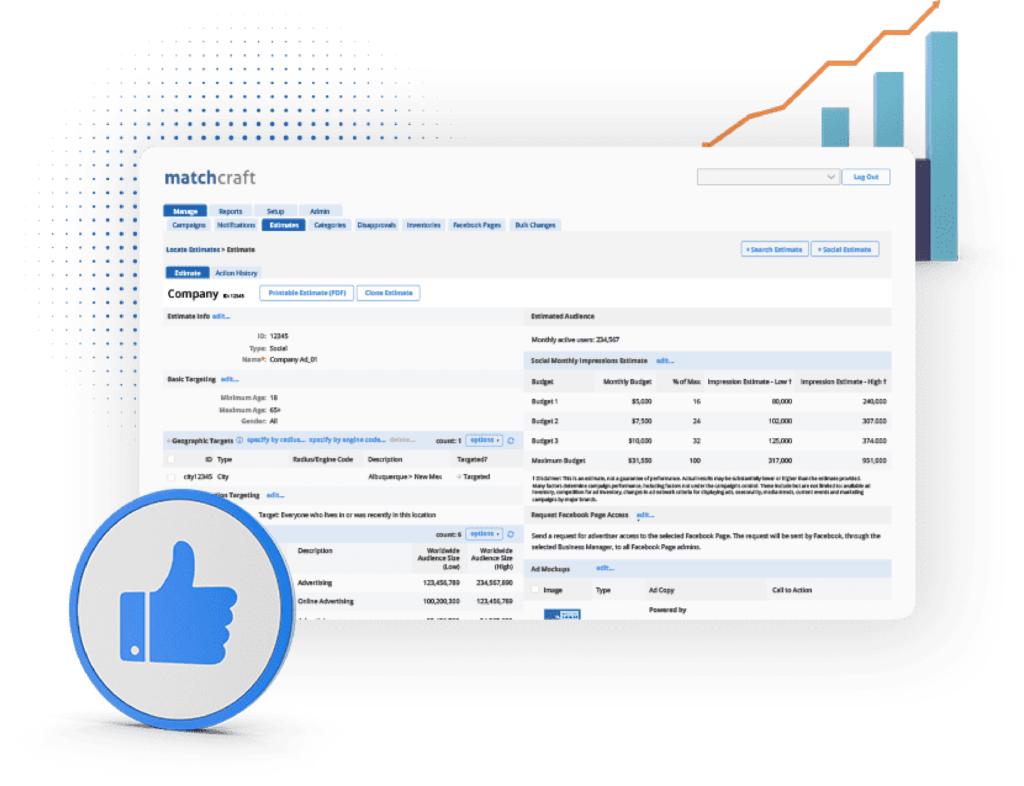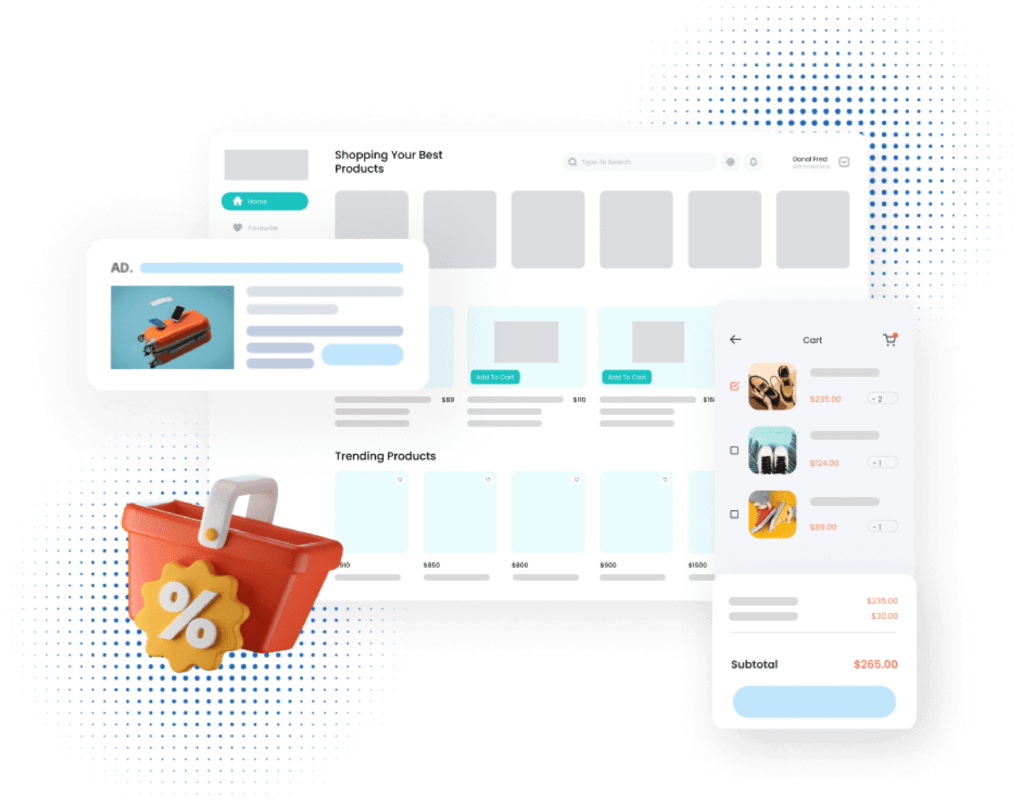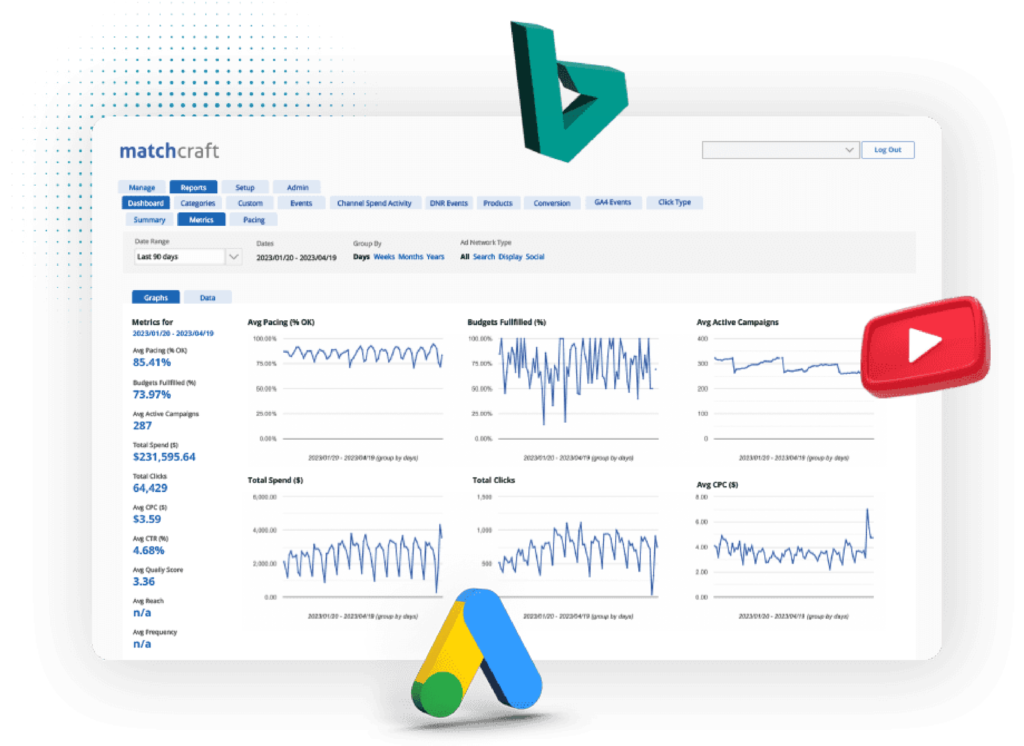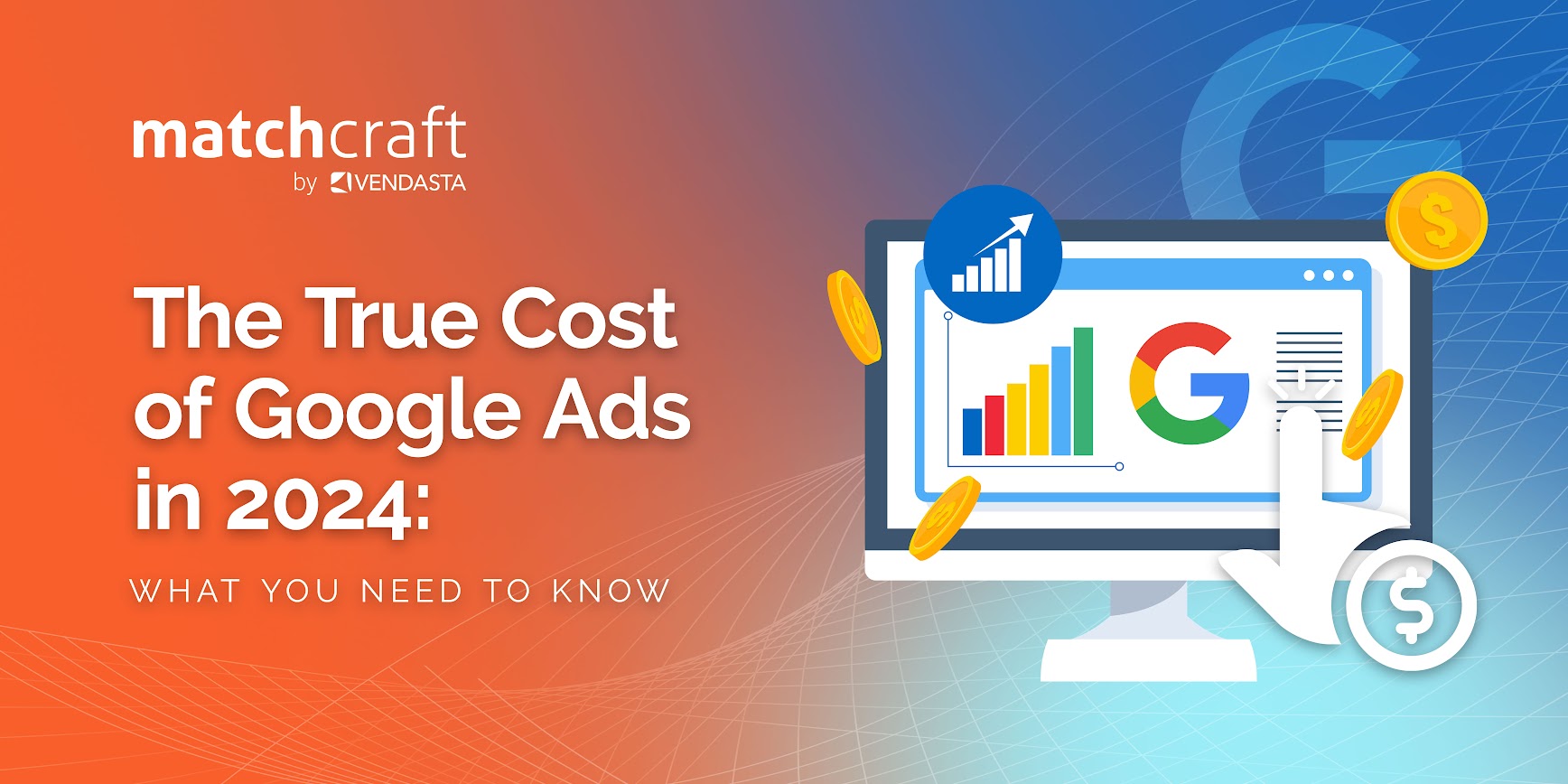Google Ads is one of the powerful ways for businesses to reach targeted audiences. However, as the landscape evolves, so too does the complexity of managing costs associated with these campaigns.
Determining the true Google Ads cost is a real challenge as it’s influenced by various parameters. The cost can vary based on industries, keywords, Quality Score, market trends, and more.
Does it sound so confusing? We’ve got you! We’ll guide you through all the variables and help you understand Google Ads pricing to maximize the return on investment (ROI) for your PPC clients.
Supercharge your clients’ PPC campaigns with our cutting-edge platform designed to improve your ROI.
How Google Ads Costs Are Determined
The Google Ads cost is determined primarily through the auction system. What is it? How does it work?
Here’s all you need to know:
Overview of the Google Ads Auction System
Google Ads operates on an auction system that kicks in whenever someone searches for a keyword you’re targeting. It’s not a traditional auction where the highest bidder always wins. Instead, Google uses a combination of factors to determine which ads appear and how much advertisers pay.
Here’s how it works:
- Advertisers bid on keywords relevant to their products or services.
- Google evaluates all ads eligible to show for a given keyword, considering factors like bid amount, ad quality, and relevance.
- Ads are ranked, and those with the highest ranks appear on the search results page.
Key Factors Influencing Cost
Quality Score: It’s Google’s rating of the relevance and quality of your ad, keywords, and landing page. It’s scored from 1 to 10, with 10 being the best. A good score can reduce your cost-per-click.
For instance, if you and a competitor both bid $2 for the same keyword, but your Quality Score is 9 while theirs is 6, your ad might rank higher, and you could end up paying less per click.
Ad Rank: Ad Rank determines the position of your ad on the search results page. It’s calculated using your bid amount, Quality Score, and the expected impact of your ad extensions (like site links).
Ads with a higher Ad Rank appear higher on the page, and advertisers only pay what’s necessary to outbid the next highest competitor. So, even with a lower bid, a great Quality Score can help you rank higher and pay less.
Maximum Bid: This is the maximum amount you’re willing to pay per click on your ad. It’s part of the formula used to calculate Ad Rank, but it’s not necessarily what you’ll pay.
While a higher bid can increase your chances of ranking higher, you only pay just enough to beat the next competitor, not necessarily your maximum bid.
For example, let’s say your max bid is $3, and the next highest bidder is offering $2.50. You’ll only pay slightly more than $2.50, not the full $3.
Understanding Cost-Per-Click (CPC)
Cost-per-click (CPC) is the amount you pay each time someone clicks on your ad. Google calculates CPC using this formula:
Actual CPC = [Ad Rank of the advertiser below you / Your Quality Score] + 0.01
When do you get charged? You only pay when someone clicks on your ad, not just when it appears.
Pro Tip: Want to improve CPC for your PPC clients? Try our PPC solution for agencies that provide intelligent budget optimization and seamless campaign management options.

Factors That Influence Google Ads Cost
Google Ads costs aren’t the same across all industries. Factors such as competition and customer value play a huge role in determining how much Google Ads costs in your industry.
Let’s dive into the details!
Industry and Competition: Cost Variation by Industry
Industries with high demand and significant competition for those keywords often face higher costs per click (CPC).
Here’s a breakdown of how costs can differ:
High-Cost Industries: These industries often target competitive keywords where businesses are willing to pay more to attract customers. Industries such as financial and legal services usually command a higher CPC ranging from $2 to $10.
Low-Cost Industries: On the other end, industries with less competition or lower customer lifetime values tend to have lower CPCs, ranging from $1 to $2.
Industries with high customer lifetime value (CLV) often face higher ad costs. That’s because businesses in these industries are willing to spend more on ads, knowing the potential return from each customer is substantial.
Understanding these dynamics can help you plan your clients’ ad strategies and budgets more effectively, ensuring they get the most out of their ad spend.
Keyword Selection and Its Impact on Costs
Choosing the right keywords in your Google Ads campaign can significantly impact how much you pay per click.
Let’s explore how keyword selection affects costs and some strategies to keep your spending under control.
Keyword Influence on Google Ads Costs
The keywords you target directly influence your CPC. Some keywords are more expensive than others, depending on their popularity and competition. Conducting thorough PPC keyword research is the key to success.
There are two main types of keywords:
- Short-Tail Keywords: These are broad, often one- or two-word keywords like “shoes” or “lawyers.” They tend to have a high search volume but are highly competitive, which increases their CPC. For instance, a keyword like “lawyer” might cost $40 per click because many businesses are bidding on it, making it expensive to rank for.
- Long-Tail Keywords: These are more specific, multi-word phrases like “affordable running shoes in New York” or “criminal defense lawyer near me.” Long-tail keywords have lower search volume, but they’re less competitive, making them more affordable.
Strategies for Cost-Effective Keyword Selection
To effectively manage PPC costs, focus on finding a balance between search volume, competition, and relevance.
Prioritize long-tail keywords, as these keywords are usually less expensive and help you target users with specific intent. While they may attract fewer clicks, the quality of those clicks is often higher.
Using tools like MatchCraft Platform, Google Keyword Planner, SEMrush, and Ahrefs can help you find cost-effective keywords. They provide data on keyword search volume, competition, and estimated CPC, helping you make informed decisions.
Look for keywords with moderate search volume and low to medium competition to maximize your budget. Make sure your keywords match your audience’s intent. Even if a keyword has a lower CPC, if it doesn’t drive relevant traffic, you’ll waste your budget.
Pro Tip: Optimize your keyword selection with MatchCraft’s proprietary ad copy and keyword library that covers 2500+ categories for SMBs in more than 22 languages.

Quality Score and Its Cost Implications
Your Google Ads Quality Score is an important factor in determining how much your Google Ads cost and where they appear. A higher Quality Score can help lower your CPC and improve your ad rank.
Components of Quality Score
- Expected Click-Through Rate (CTR): How likely it is that people will click on your ad.
- Ad Relevance: How closely your ad matches the keywords and search intent.
- Landing Page Experience: How useful and relevant your landing page is to people who click on your ad.
The biggest advantage of having a good Quality Score is that your ads may rank higher on search results even if you bid lower than a competitor.
How to Improve Quality Score to Reduce Costs
Follow these actionable strategies to improve your Quality Score:
- Refine Ad Copy: Ensure your ad copy is highly relevant to the keywords you’re targeting and use dynamic keyword insertion to match search queries more closely.
- Enhance Landing Page Experience: A fast-loading and mobile-friendly landing page with relevant content provides a clear value proposition.
- Improve Ad Relevance: Group keywords into tight ad groups for better targeting. And use negative keywords to filter out irrelevant searches and keep your ads focused.
- Optimize CTR: Conduct A/B testing for ad variations to see which copy or headlines drive more clicks.
Average Google Ads Costs Across Industries
Google PPC charges vary widely depending on the industry, competition, and other factors. Understanding these variations can help businesses set realistic budgets and maximize the value of their ad spend.
Current Average CPC Data
Based on recent data, here are the average cost-per-click (CPC) rates across some key industries:
| Industry | Average CPC |
| Legal | $6.83 |
| Financial Services | $3.44 |
| Online Education | $9.35 |
| Real Estate | $1.87 |
| Automobile | $1.63 |
| Fashion Retail | $1.48 |
| Travel | $1.34 |
| Beauty | $1.61 |
| Healthcare | $4.22 |
| Insurance | $8.41 |
These costs reflect the level of competition and potential revenue that businesses in these sectors can generate from each customer. Higher-value industries, like legal and insurance, often see higher CPCs due to the significant return on investment from each conversion.
Factors Leading to Cost Variations
- Location: Ads targeting specific cities or regions with higher competition, such as New York or Los Angeles, tend to have higher CPCs.
- Seasonality: Certain industries experience fluctuations in ad costs depending on the time of year. For example, retail CPCs can spike during the holiday shopping season, while travel ads may see higher costs during peak vacation months.
- Ad Competition: As more businesses enter the market and compete for the same keywords, ad costs rise. Industries with high customer lifetime values or large profit margins typically see more competition, driving up CPCs.
By staying aware of these factors, businesses can better anticipate and manage fluctuations in their Google Ads budgets.
Budgeting for Google Ads Campaigns
Setting a clear budget is one of the most critical steps in running a successful Google Ads campaign. A well-planned PPC budget helps you control costs and align your spending with business goals.
Let’s break down how to create an effective budget for your campaigns, whether you’re just getting started or managing multiple PPC campaigns across various ad groups:
Understanding Daily and Monthly Budgeting
Google Ads allows you to set both daily and monthly budgets to control how much you spend on advertising. Here’s a simple guide to get started:
Daily Budget: This is the amount you’re willing to spend per day on a particular campaign. Google will try to spend up to that limit each day, though some days it may spend slightly more or less.
For example, if you set a daily budget of $20, you’ll generally spend around $600 per month (20 x 30 days). However, on high-traffic days, Google might spend $22, but the total over the month will not exceed your intended monthly spend.
Monthly Budget: While Google focuses on daily budgeting, you can control your monthly spend by multiplying your daily budget by the number of days in a month. Google won’t charge more than this calculated monthly total.
For instance, if your daily budget is $30, your monthly spend would be approximately $900 (30 x 30 days).
Setting Realistic Budgets Based on Campaign Goals
- Brand Awareness Campaigns: If your goal is to get your name out there, a modest budget can work. Focus on a high number of impressions (views) rather than clicks.
- Lead Generation or Sales Campaigns: These campaigns often require a larger budget, especially in competitive industries. The goal is to drive conversions (leads or sales), so you may need to allocate more to outbid competitors.
- Seasonal Campaigns: For businesses with seasonal spikes (e.g., e-commerce during the holidays), budgets might need to be increased temporarily to capitalize on peak times.
Allocating Budget Across Campaigns and Ad Groups
When running multiple campaigns or ad groups, it’s essential to distribute your budget efficiently.
Here’s how to approach it:
- Start by identifying which campaigns are most critical to your business goals (e.g., product launches, high-converting services).
- Allocate more budget to campaigns or ad groups that are delivering the best results (higher conversions or lower CPC).
- Within each campaign, you’ll have different ad groups targeting specific keywords or audiences. Allocate your budget to the highest-performing ad groups.
PPC budgeting for Google Ads campaigns requires careful planning to ensure you’re spending wisely. Start by setting daily budgets that align with your monthly goals. Then, allocate budgets based on your campaign priorities and results, using tools like Google Ads Editor and automated rules to manage spending effectively.
Need help in optimizing your shopping ads budget? Try MatchCraft’s PPC Management for product shopping and achieve maximum ROI.

Strategies to Optimize Google Ads Costs
Optimizing your Google Ads campaigns can significantly reduce costs while improving results.
Here are some key strategies to help you lower your spend and increase ROI:
Enhancing Ad Relevance and Targeting
Ensure your ad copy directly addresses the keywords you’re bidding on. This makes your ad more relevant and increases the chances of clicks. For instance, if you’re targeting “affordable web design services,” your ad should mention pricing or discounts to match search intent.
Utilizing Ad Scheduling and Geotargeting
Ad scheduling and geotargeting can optimize your ad spend by ensuring your ads are shown at the right times and locations:
Run your ads only during hours when your target audience is most active. This prevents wasting budget when people are less likely to convert. If you’re running a PPC campaign for a restaurant, you can schedule ads during lunch and dinner hours to reach users when they are likely to order.
Focus your ads on specific regions or cities where your services are most in demand. This reduces wasteful spending on users outside your service area.
Improving Click-Through Rates (CTR) to Reduce CPC
A higher CTR leads to a better Quality Score, which can reduce your CPC. Here are some tips to improve CTR:
- Write Compelling Ad Copy: Use clear, engaging headlines with strong calls to action (CTA). Incorporating offers like “20% Off” or “Free Consultation” can entice more clicks.
- Use Eye-Catching Visuals: For display ads, compelling images or video content can increase CTR. Use images relevant to your target audience that clearly reflect your product or service.
Leveraging Negative Keywords
Negative keywords prevent your ads from showing for irrelevant searches, ensuring your budget is only spent on valuable clicks:
- Add Negative Keywords: Identify terms that are not related to your product but are still triggering your ads. For instance, if you sell high-end shoes, add “cheap” or “discount” as negative keywords to avoid wasting money on bargain hunters.
- Example: A legal firm specializing in corporate law may add “divorce” as a negative keyword to avoid clicks from unrelated queries.
Measuring ROI and Managing Ongoing Costs
To effectively manage Google Ads costs and maximize ROI, you’ll need to monitor key performance indicators (KPIs), calculate your return on ad spend (ROAS), and continuously optimize your campaigns.
Key Performance Indicators (KPIs) to Monitor Costs
Tracking these key PPC metrics will help you measure ad performance and manage costs:
- Cost-Per-Click (CPC): The amount paid for each click on your ad. Lower CPC can reduce overall costs without sacrificing traffic.
- Click-Through Rate (CTR): The percentage of people who clicked on your ad after seeing it. A high CTR can improve Quality Score and lower CPC.
- Return on Ad Spend (ROAS): A key indicator of profitability, ROAS measures how much revenue you earn for each dollar spent on ads.
Calculating Return on Ad Spend (ROAS)
ROAS measures the effectiveness of your ad campaigns in generating revenue. The formula is:
ROAS = [Revenue from Ads / Cost of Ads] x 100
Example:
If you spent $500 on ads and earned $2,000 in revenue, your ROAS would be:
ROAS = [$2000 / $500] x 100 = 400%
This means for every $1 spent, you earned $4 in revenue. A higher ROAS indicates better campaign efficiency.
Ongoing Cost Optimization Strategies
- Monitor Performance Regularly: Keep an eye on your CPC, CTR, and ROAS to identify areas for improvement. Adjust budgets and bids based on keyword performance.
- A/B Test Ad Elements: Test different versions of ad copy, images, and CTAs to find what resonates most with your audience and drives higher conversion rates at a lower cost.
- Use Automated Bid Strategies: Switch to target CPA or maximize conversions to automatically optimize bids for the best cost-per-conversion results.
By consistently tracking KPIs and using these strategies, you can ensure your Google Ads campaigns remain cost-effective while delivering strong ROI.
Need help in analyzing your KPIs and campaign performance? Try MatchCraft Platform to get comprehensive insights into your PPC campaign performance and make changes to achieve better results.

Future Trends in Google Ads Cost Management
With rapid changes in digital advertising, it’s inevitable that Google Ads cost management will continue to be influenced by new technologies, regulations, and market dynamics.
Here’s a look at the trends shaping the future and how advertisers can adapt to stay competitive:
Emerging Trends Impacting Google Ads Costs
- AI-Driven Bidding: Artificial intelligence (AI) is already transforming Google Ads, and it’s expected to become even more central to bidding strategies. AI-driven solutions like smart bidding use machine learning to adjust bids in real-time based on user behavior, time of day, and other ad campaign metrics.
Impact on Costs: As AI optimizes for conversions, advertisers may see more efficient spending, with improved return on ad spend (ROAS) over time. However, it could also drive up competition, especially in highly competitive sectors.
- Privacy Regulations: With increasing emphasis on privacy (e.g., GDPR and California’s CCPA), changes to how data is collected and used will impact Google Ads campaigns. Google’s move toward privacy-first advertising with its Privacy Sandbox and phasing out third-party cookies are likely to reduce granular targeting options.
Impact on Costs: Advertisers may see higher costs per conversion as targeting becomes less precise. First-party data will become increasingly valuable in maintaining ad effectiveness.
- New Ad Formats: Google is constantly rolling out new ad formats like YouTube Shorts ads or Discovery ads to meet changing user behaviors, particularly around mobile and video consumption. These formats provide new ways to engage users but also require new strategies to maximize ROI.
Impact on Costs: Early adopters of new formats may experience lower CPCs due to less competition, but costs could rise as more businesses embrace these trends.
Adapting Cost Management Strategies
To stay ahead of these changes, here are some tips for adapting your Google Ads cost strategies:
- Leverage AI Tools: Stay competitive by adopting Google’s Smart Bidding strategies like Target ROAS and Maximize Conversions. These tools will help you remain efficient as AI continues to evolve.
- Focus on First-Party Data: Build robust data collection practices to capitalize on first-party data for targeting. Use tools like Google Analytics 4 (GA4) to collect user insights without relying on third-party cookies.
- Test New Ad Formats Early: Experiment with new ad formats when they are introduced. By staying ahead of competitors, you can enjoy lower CPCs and gain valuable insights into what resonates with your audience.
- Prepare for Privacy Changes: Regularly update your targeting and attribution strategies in response to new privacy laws. Invest in customer relationship management (CRM) tools that help you segment audiences based on first-party data.
Pro Tip: Leverage MatchCraft’s AI-powered enterprise digital marketing solutions to manage your PPC costs across multiple platforms.

Conclusion
While the true cost of Google Ads in 2024 varies based on industry, competition, and strategies, businesses can still achieve great returns by staying informed and proactive. By focusing on ad relevance, targeting efficiency, and leveraging new tools and trends, you can manage your Google Ads costs effectively and make the most out of your advertising dollars.
It isn’t just in what you spend—it’s in how well you manage that spend to drive meaningful results for your business. Contact us today to manage your clients PPC campaigns and drive impressive results quickly.
